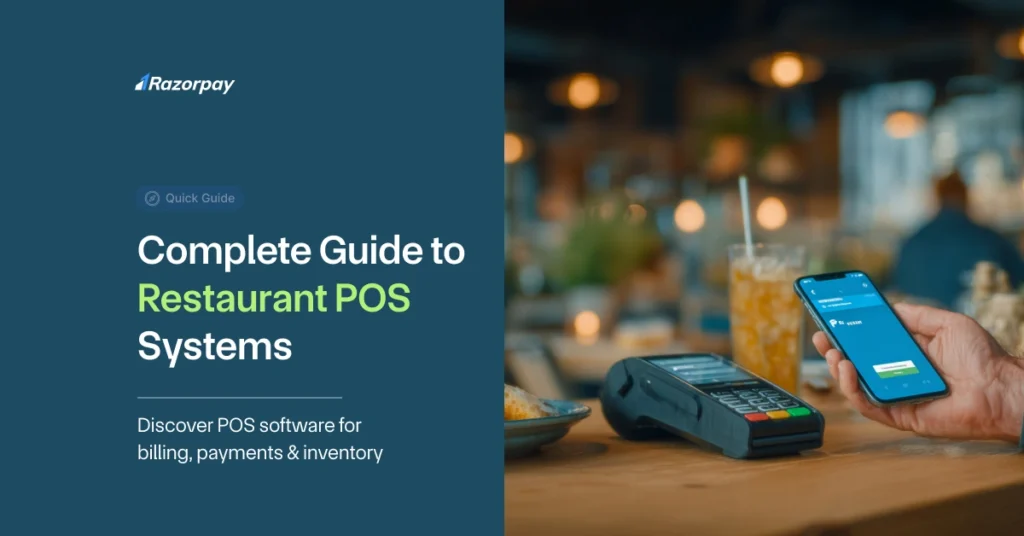Key Takeaways
The food and hospitality industry underwent a significant transformation during the COVID-19 pandemic in 2019. Many shut shop and those that sustained scaled up their infrastructure to accommodate the needs of modern diners.
A Restaurant PoS system helps restaurants take orders, process them and even facilitates easy transactions. Razorpay’s PoS solutions are reliable and easy to use, making it one of the top payment gateway choices in India.
What Are Restaurant PoS Systems?
Restaurant PoS systems form the backbone of modern restaurant management. The overall ecosystem is well designed and synchronized to deliver optimum service and profitability. Unlike traditional point of sale systems, modern players have designed the latest software to adapt to customers’ growing needs. It comprises multiple components – from tools that support front-end operations to backend programming. Modern restaurant PoS systems are cloud-based, making them adaptable to any sudden changes in mode of operation. This is a boon to modern-day restaurant owners.
Key Features of a Restaurant POS System
Order Management: Front-end tools that accept dine-in, takeaway, or online orders and route them directly to the kitchen.
Table Management: Generally comprise tabs or handheld phones to track reservations, waiting lists, and table occupancy in real-time.
Billing & Invoicing: Generate GST-compliant invoices quickly with multiple payment options.
Inventory Tracking: Monitor stock levels, get alerts for low inventory, and manage suppliers.
Multi-Location Support: Manage multiple outlets with a consolidated dashboard.
Integrated Payments: Accept UPI, cards, wallets, and netbanking through Razorpay’s secure network.
Reports & Analytics: Consistent data tracking allows management to analyse reports and make data-backed decisions.
Some of the best PoS systems in restaurants make the entire process from the beginning to end, seamless and help reduce errors as much as possible.
Types Of Restaurant PoS Systems
Restaurant PoS systems vary depending on the needs they are programmed to fulfill. These are mainly categorised into cloud-based POS, on-premise POS, mobile POS, all-in-one POS, and hybrid POS systems.
Cloud-based systems:
These PoS systems are equipped to store more data, are accessible from any place, through any device. The main highlight of cloud-based systems is that these offer real-time syncing, are updated automatically and provide restaurant owners with insightful data for future improvisation. Best suited for cloud kitchens or up-and-coming restaurants.
On-premise PoS:
These systems store data locally; however, they require dedicated servers. These are highly customisable, however, these systems cannot be used everywhere since they incur high upfront costs and maintenance. On-premise PoS systems are more suited to larger, well-established restaurants or restaurant chains.
Mobile PoS Systems:
Mobile PoS systems enable restaurants to operate more flexibly, allowing them to take orders and process payments through mobile devices and manage them remotely. These are primarily used by smaller eateries like food trucks, etc.
Hybrid PoS Systems:
These PoS systems enable restaurants to operate both online and offline. Restaurants located in places with limited availability of the internet or those that handle a very high volume of traffic can benefit from such PoS systems.
How Do Restaurant PoS Systems Work?
Restaurant PoS systems primarily use dedicated servers, software and hardware to integrate several restaurant operations to execute flawless delivery in restaurants. Before taking a look at how they work, let’s understand the primary components of a good restaurant PoS system.
A typical PoS system has hardware and software components that work in tandem to deliver the ultimate dining and delivery experience to customers.
Hardware
PoS Terminal
This is a phone or a tablet which is the primary interface between restaurant operations and the PoS software. Staff can input their orders, manage transactions and access system functions.
Card Reader/Payment Terminal
A card reader is used for payments. Swift payments are instrumental to smooth functioning of restaurants. Razorpay’s PoS solutions facilitate seamless transactions, with easy to use interface, contributing to the overall success of restaurant operations.
Kitchen Display System
Machines that relay orders directly to kitchen staff, seamlessly.
Customer Facing Display
Used to display transactions to customers, representing transparency and clarity to those involved.
QR Code Scanner
Efficient QR code scanners aid accurate and easy payments, leading to successful, reliable and secure transactions.
Software
PoS Application
This is the main software that facilitates most of the restaurant’s operations.
Inventory Management Software
Helps manage and take stock of daily inventory, provides an overview of what is exhausted and allows the team to make data-driven decisions.
CRM and Loyalty Module
This system stores customer information, tracks their visits and manages loyalty programs that the restaurant may have.
Reporting & Analytics
This part of the restaurant PoS system collects information relevant to the various restaurant functions which can be later used for quality analysis. This further leads to the management making careful, well-calculated decisions.
Integration Services
The heart of the PoS system that connects all the different hardware and software components to work together, helping your business to take off, thrive and remain successful.
How Does It Work?
Order Entry
Staff logs in using their respective login credentials. As soon as the first order is received, it is logged into the PoS terminal, which is typically a monitor or a hand-held device. Once the order has been linked to a certain customer’s name or their table number, it is sent into the kitchen for processing.
Kitchen Coordination
The PoS system routes the order received through the PoS terminal into the kitchen display, signalling kitchen staff about a new order. Any customisation noted along with the order is also displayed on the kitchen display system. The staff mark the status of progress on the interface (Under progress, ready to go, processed). This is synced with the integration services which relay the information to the PoS terminal.
Billing And Payments
Billing software is linked to the PoS software, which automatically calculates the order total, including taxes, discounts, service charges and applicable extra fees. This is where Razorpay’s expertise comes in handy. Our interfaces are easy to navigate with clear instructions and a seamless handshake between the different payment phases.
Receipt Generation
Once the payment is processed successfully, a receipt is generated by the credit card terminal and provided to the customer.
Inventory Upgrade
When an order is processed, inventory is automatically upgraded, alerting the staff when there is any shortage of ingredients. This helps kitchen staff plan in advance for rush days so orders can be implemented without a hodgepodge.
Reporting Analytics
The daily operations are recorded and analysed for further planning and decision-making.
Why PoS Systems Are Relevant Today?
In an age where instant is the keyword, the idea of a great dining experience is swift delivery and hospitable service by the restaurant staff. A restaurant PoS system supports a successful workflow and delivery all the way through. Razorpay’s payment solutions have supported many up and coming and well-established restaurants achieve their delivery goals through our continuous efforts to scale up and remain in sync with the current requirements of the industry.
FAQs
What Are Some Of The Key Features To Look For in Restaurant PoS?
An efficient PoS system must be equipped with robust software that makes it easy to manage daily restaurant operations. Here are some of the most important features that one must look for in a restaurant PoS.
- A user-friendly interface.
- Order and menu management.
- Inventory management
- Table and seating management.
- Reporting and analytics.
- Seamless integration with online ordering and delivery.
- Robust security and data protection.
How Secure Are Restaurant PoS Systems?
Modern solutions provide robust security with data encryption, secure payment gateways, and compliance with industry standards for data protection.
How Much Does a Restaurant PoS System Cost?
Costs vary based on system type, features, hardware needs, and business size. Many providers offer flexible pricing plans for anything from small food trucks to large restaurants.

